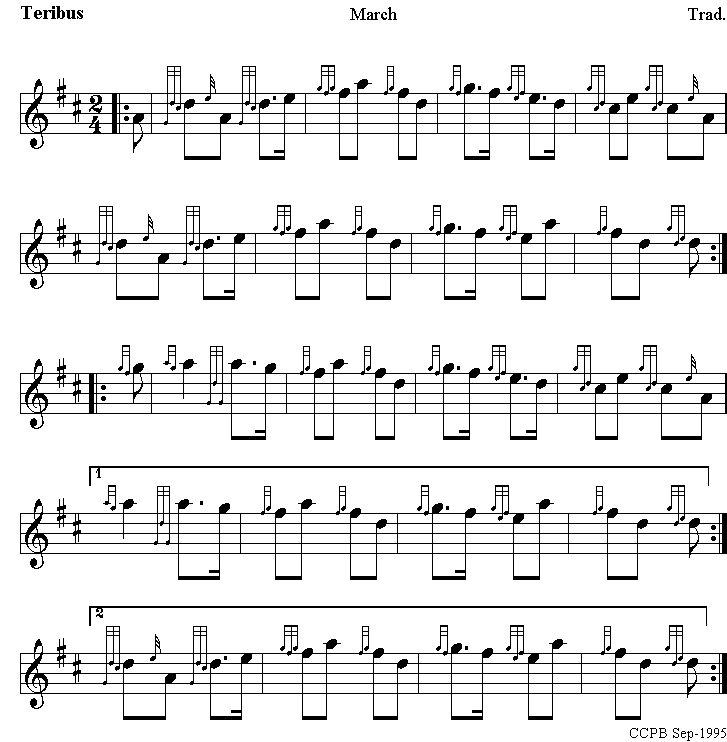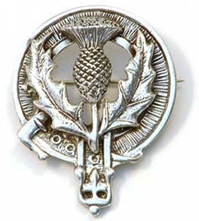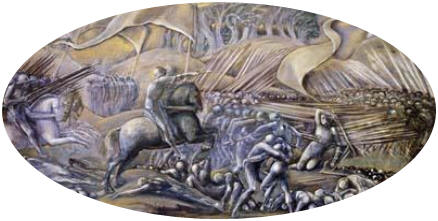Teribus (tee-ree-bus) is a short form of the Hawick slogan and battle-cry, ‘Teribus ye Teri-Odin,’ the war cry of the men of Hawick at the Battle of Flodden Field, and is still preserved in the traditions of the town. The full chorus was often sung at festive gatherings, not only in the gallant old border town itself, but in the remotest districts of Canada, the United States and Australia, wherever Hawick men, and natives of the Scottish Border congregated to keep up the remembrance of their native land, and haunts of their boyhood.
- "Teribus ye teri odin
- Sons of heroes slain at Flodden
- Imitating Border bowmen
- Aye defend your rights and common"
The full song is still sung at the Hawick Common Riding in June of every year.
Hawick (hIk, hoik) is in Southeast Scotland, at the confluence of the River Teviot and the Slitrig Water, in the old county of Roxburghshire, where it is the largest town. One of Scotland’s leading textile centers, it is also famous for its Common Riding, rugby, and long tradition of civic independence. It is first recorded in 1214, and built up around the Tower and St. Mary’s Church. It has been a Burgh of Barony from at least 1511, with the earliest existing Charter being from Sir James Douglas in 1537. It was burned by the English in 1418, 1548 and 1565, and the inhabitants burned it themselves in 1570 so as to not to provide food or shelter to the invaders.
Many Hawick residents speak the local dialect of Border Scots which is informally known as "Teri Talk.” You can download an extensive explanation of Teri Talk at:
http://www.astro.ubc.ca/people/scott/book.pdf
In Teri Talk, a Teri (tee-ree) is someone from Hawick; deriving from the abbreviation of the ancient Hawick slogan, Teribus ye teri odin. The plural is Teries. Odin ( ̄odin) refers to the supreme Norse deity, god of wisdom, art, culture and the dead, traditionally thought of as one of the gods in the Hawick battle cry ‘Teribus ye Teri-Odin’ – ‘Scotia felt thine ire, O Odin! On the bloody field of Flodden’
Teribus (tee-ree-bus) is the main Common Riding song, written by James Hogg in 1819, to a tune which is surely much older, and bears a similarity with tunes derived from Northumbrian pipe music. Originally called ‘The Colour’, and first published in Kelso it is sometimes also referred to as ‘The New Common Riding Song’, to distinguish it from Balbirnie’s song of perhaps a generation earlier, which had the same tune. An even earlier version had as the chorus ‘T for Teri, O for Odin, H for Hawick and C for Common’, but none of the rest survives.
The Battle of Flodden or Flodden Field was fought in the county of Northumberland, in northern England on September 9, 1513, between an invading Scots army under King James IV and an English army commanded by Thomas Howard, Earl of Surrey. It ended in a bloody defeat for the Scots and was the largest battle (in terms of numbers) fought between the two nations.
This conflict began when King James declared war on England, to honor the Auld Alliance with France by diverting Henry VIII's English troops from their campaign against the French king Louis XII. England was involved in a larger conflict; defending Italy and the Pope from the French, as a member of the "Catholic League". Using the pretext of revenge for the murder of Robert Kerr, a warden of the Scottish East March, who had been killed by John "The bastard" Heron in 1508, James of Scotland invaded England with an army of about 30,000 men.
The battle actually took place near the village of Branxton, in the county of Northumberland, rather than at Flodden — hence the alternative name of Battle of Branxton. The Scots had previously been stationed at Flodden Edge, to the south of Branxton.
Most of the Hawick's men of fighting age were killed at the Battle of Flodden. The following year Hawick was threatened by a raiding party of English troops. They were fought off by the boys, or "callants" of the town, who captured the English flag. This event is commemorated by a statue of a horse and rider (shown below) at the north east end of the High Street and by the annual "Common Riding", in which several hundred riders gather to ride around the boundaries of the burgh. This takes place in early June each year.



